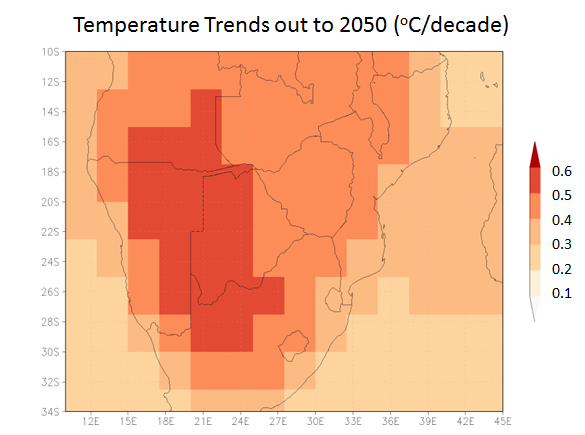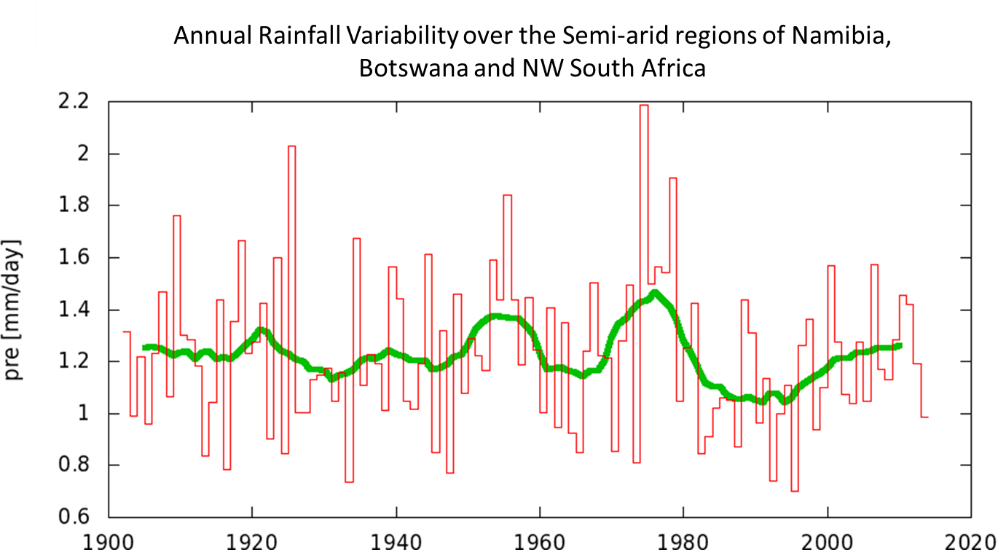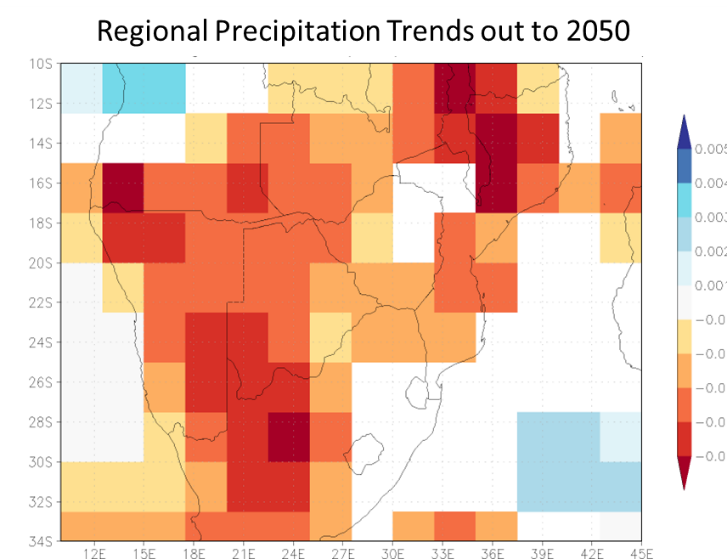Are semi-arid regions climate change hot-spots?
Are semi-arid regions climate change hot-spots? Evidence from Southern Africa
By Mark New

Semi-arid regions of the world are often thought of as being particularly vulnerable to climate change. They are already climatically stressed with high temperatures, low rainfall and long dry seasons. Semi-arid ecosystems are highly dynamic, with bursts of productivity in the wet season and in good years, and very low productivity in dry years, often leading to temporary or longer term land degradation. Traditionally, inhabitants of semi-arid areas managed this variability in natural resource availability though pastoralism or agro-pastoralism. Nowadays, population growth, land-ownership issues, national borders and competition with other land-uses has reduced the opportunities for people to respond in traditional ways to the ecosystem dynamics of these systems, and has resulted in many instances of enhanced vulnerability to climatic variability. ASSAR is undertaking research in semi-arid hotspots of Africa and India, to understand the nature of vulnerability to climate change, and the barriers and enablers for successful adaptation to climate change.
While people in semi-arid areas are clearly affected by a multi-stressor social, political-economic and ecological environment, we can ask the question whether we can legitimately think of these drylands as climate change hotspots – are the rates of climate change that have been experienced greater than other areas in Africa, and are the projected changes going to similarly more severe?
As with most analyses of climate change we can say a lot more about temperature change and its related impacts than rainfall. Temperature increase is largely a direct consequence of changes in greenhouse gases, with increased temperature experienced and expected all over the world. The rate of temperature increase depends however on a mix a global and local feedbacks (see this description of key feedbacks). With regard to semi-arid areas, the question is whether some of these feedbacks act to make warming particularly severe compared to global or surrounding regional averages.

Mean temperatures over southern African semi-arid areas have increased by 0.25 degrees per decade since 1960. These increases are about 30% larger than the warming seen across the wider Southern African region. Climate model projections show a similar pattern of faster increases in temperature over semi-arid areas in the future. The average across all models indicate a warming rate of between 0.32 and 0.38 degrees per decade out to 2050, depending on future GHG emissions being either moderately reduced or not reduced at all. These projected trends are 35-40% larger than the warming for the wider Southern Africa region, suggesting that the accelerated warming seen already will become even worse in the future. We would expect temperature-related impacts to be greater, and any critical thresholds such as livestock heat-stress, to be breached sooner in semi-arid areas compared to other parts of the region.
One of the main underlying reasons for this enhanced warming is most likely due to a moisture and evaporation feedback. As warming progresses, the rates of evaporative demand increase, leading to drier soils. This then leads to greater heating of the land surface and warmer temperatures in areas that are already dry. In more humid areas, the heat is used to evaporate more water rather than directly heat the land surface. This feedback is even stronger if rainfall and cloudiness decrease (see below).

Turning to rainfall, there is not a strong trend in changes over southern African semi-arid areas, either in the recent past, or in the future. The past fifty years show high decadal and year to year variability in rainfall, but no significant trend. From one year to the next, rainfall can vary between 40% below and 70% above the long term average. There has also been a pattern of drier and wetter decades; for example the 1970s were about 20% wetter than the long term average, while the 1990s were about 15% drier; the last decade has been about average. These patterns of variability are similar over the wider non-semi-arid Southern Africa, but the variation in semi-arid areas are more extreme - for example, year to year variations over the broader region are -23% to +33% (compared to -40% to +70% for SARs).
Across all climate models there is a suggestion of reduced total rainfall in the future, but a significant proportion of models, about 25%, indicate increased rainfall. While we know that changes in variability will be as important as changes in long term average rainfall, we again get no clear signal from climate models on this issue. However, it is probably a safe bet to expect that the variability in rainfall of the recent past will continue into the future. This means that many of the current vulnerabilities to dry and wet periods will likely be experienced in the future. Responses that aim to reduce this vulnerability could be the most important near term climate adaptation action.

Unlike temperature, rainfall is a much more difficult process for climate models to simulate accurately. Rainfall depends on, among other factors, the large scale circulation, the amount of moisture evaporated from surrounding oceans and land, and then its transport by this circulation, and local meteorological processes, such as convection, that deliver the moisture to the surface as rainfall. Some of the mixed picture we currently get from climate models about rainfall changes over semi-arid regions is probably due to biases in their simulation of the large scale circulation of these regions. For instance, rainfall over Botswana depends on the interaction of tropical and sub-tropical circulations, and each climate model is slightly different in where this interface lies in its “model” world. Any changes in this circulation pattern under climate change will be partly a function of each individual model’s basic-state biases. Therefore, the predicted changes in rainfall across models may be quite varied, but if we look at changes in the underlying circulation in each model, we might see a more consistent picture. This is definitely an area in need of more research in Southern Africa.
So, are the climate changes we have seen over Southern Africa, and those that are projected for the future, consistent with the notion that semi-arid areas are hot-spots? We have seen faster rates of temperature rise over semi-arid areas of Southern Africa, and future warming is also projected to be exaggerated in the dryland areas. Total rainfall is lower, and inherently more variable, in southern African semi-arid areas, suggesting higher intrinsic vulnerability than surrounding areas. Although we have not detected any long term trend in either rainfall variability or average rainfall to date, the majority of climate models suggest reduced rainfall in the future. Although more research is needed to understand whether these projected changes make sense from a climate system dynamics point of view, it does appear that semi-arid areas will indeed be environments that experience some the largest and most impactful changes in climate over the next several decades.